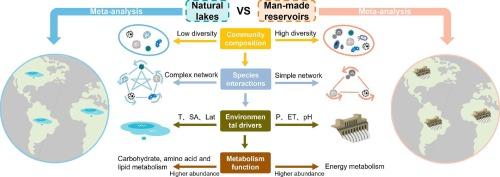Reservoirs enhance bacterial diversity but destabilize microbial co-occurrence network compared to natural lakes: A global meta-analysis
IF 6.3
1区 地球科学
Q1 ENGINEERING, CIVIL
引用次数: 0
Abstract
Globally, reservoirs have proliferated, becoming significant water bodies comparable to natural lakes. However, the functional equivalence between reservoirs and lakes in sustaining aquatic ecosystem services remains debated. As microbial communities are central to aquatic ecosystem functioning, they offer valuable insights into the impacts of human activities. To explore the ecological effects of anthropogenic disturbance on water bodies, this study focuses on microbes, which are drivers of ecological functions. The differences in bacterial structure, function, and main drivers between reservoirs and natural lakes were analyzed at a large spatial scale using a meta-analysis of 872 samples from 38 countries around the world. The results revealed that bacterial communities in reservoirs exhibited significantly higher richness and diversity but lower complexity and stability in microbial co-occurrence networks compared to lakes. Structural equation modeling indicated that bacterial community structure in reservoirs was significantly influenced by annual precipitation, evapotranspiration, and pH, whereas in lakes, it was primarily driven by water temperature and surface area. Notably, reservoirs showed a higher abundance of functional genes associated with human infectious and neurodegenerative diseases. Overall, these findings clarified the structural and functional distinctions between bacterial communities in reservoirs and lakes, providing new insights into the ecological impacts of anthropogenically disturbed water bodies.

与天然湖泊相比,水库增强了细菌多样性,但破坏了微生物共生网络的稳定性:一项全球荟萃分析
在全球范围内,水库数量激增,成为可与天然湖泊媲美的重要水体。然而,水库和湖泊在维持水生生态系统服务方面的功能等效性仍存在争议。由于微生物群落是水生生态系统功能的核心,它们为人类活动的影响提供了有价值的见解。为了探讨人为干扰对水体的生态影响,本研究将重点放在作为生态功能驱动因素的微生物上。通过对来自全球38个国家的872个样本的荟萃分析,分析了水库与天然湖泊之间细菌结构、功能和主要驱动因素的差异。结果表明,水库细菌群落的丰富度和多样性明显高于湖泊,但微生物共生网络的复杂性和稳定性较低。结构方程模型表明,水库细菌群落结构受年降水量、蒸散量和pH值的显著影响,而湖泊细菌群落结构主要受水温和表面积的影响。值得注意的是,宿主显示出与人类感染性和神经退行性疾病相关的功能基因的更高丰度。总的来说,这些发现澄清了水库和湖泊细菌群落的结构和功能差异,为人为扰动水体的生态影响提供了新的见解。
本文章由计算机程序翻译,如有差异,请以英文原文为准。
求助全文
约1分钟内获得全文
求助全文
来源期刊

Journal of Hydrology
地学-地球科学综合
CiteScore
11.00
自引率
12.50%
发文量
1309
审稿时长
7.5 months
期刊介绍:
The Journal of Hydrology publishes original research papers and comprehensive reviews in all the subfields of the hydrological sciences including water based management and policy issues that impact on economics and society. These comprise, but are not limited to the physical, chemical, biogeochemical, stochastic and systems aspects of surface and groundwater hydrology, hydrometeorology and hydrogeology. Relevant topics incorporating the insights and methodologies of disciplines such as climatology, water resource systems, hydraulics, agrohydrology, geomorphology, soil science, instrumentation and remote sensing, civil and environmental engineering are included. Social science perspectives on hydrological problems such as resource and ecological economics, environmental sociology, psychology and behavioural science, management and policy analysis are also invited. Multi-and interdisciplinary analyses of hydrological problems are within scope. The science published in the Journal of Hydrology is relevant to catchment scales rather than exclusively to a local scale or site.
 求助内容:
求助内容: 应助结果提醒方式:
应助结果提醒方式:


